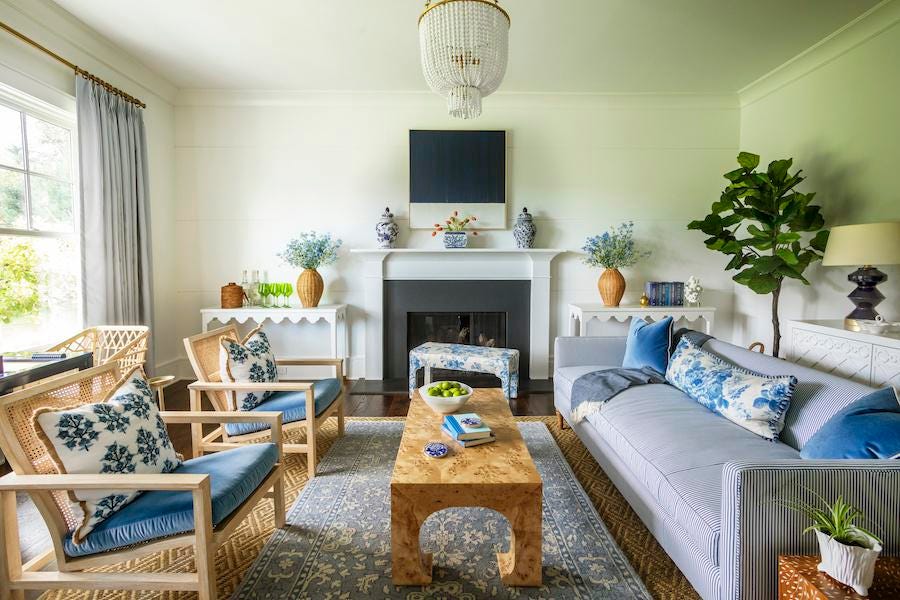There’s nothing more timeless than a traditionally designed home. This aesthetic also happens to be very much on-trend right now. From coastal grandmother to grand millennial, what’s old is new again.
However, these spaces can be more challenging to create than other styles because they’re warmer and richer. They have a soul and feeling to them that contemporary and modern homes often do not.
So how do you make a traditional space stand out and look special? Here are some of the best tips, tricks, and ideas from top interior designers.
Mixing Patterns Makes a Space More Interesting
Interior designer Jennifer Beek Hunter is a master at mixing patterns. While this can look incredible, it’s also something that the average person or even the most skilled interior designers have trouble with. It’s very easy to make mistakes.
Hunter suggests sticking to a color palette and considering the scale and proportion of the prints. “For example, we love mixing a large-scale floral with a petite stripe as seen on the sofa where we pair a floral chintz lumbar pillow on a pinstripe sofa. This balance creates a space that feels traditional, yet fresh.”
Too Afraid To Mix Patterns? Repeat Them Instead
If mixing patterns is too big a challenge, Sarah Solis, founder and principal of Sarah Solis Design Studio recommends repeating patterns. “A beautiful representation of traditional design is repeating patterns of textiles throughout the room. I love using the same print on the walls that you’re using on the window treatments and repeating patterns.”
Another way to approach this is to use the same patterns in different colors.
Comfort Is Key When It Comes To Seating
No one likes an uncomfortable sofa or chair, especially in a traditional home. “It doesn’t matter what room I’m designing—the seating has got to be comfortable, says Betsy Burnham, principal designer, Burnham Design. “I believe in sofas and chairs you and your guests want to hunker down and spend some time in—deep (but not so deep you can’t get out), plush (at Burnham Design we like a lofty down-wrapped foam upholstery insert), and beautifully (but never fussily) tailored and upholstered.”
The right fabrics can also make furniture more comfortable. “It’s about finding something appealing to both eye and touch. If it’s too stiff it won’t be welcoming; if it’s too soft it may stretch out and lose its shape over time,” explains Burnham.
The designer’s favorite fabrics are washed denim, Belgian linen, and cotton velvet. However, don’t feel limited by her favorites. If another fabric feels and soft and comfortable, then go with that.
Timing Is Everything
According to Rita Naffas, principal at Rita Naffas Design, the best traditionally designed spaces include furniture and decor from a variety of eras. “A traditional home is anchored by classic, timeless furniture that always stays in style. When designing a traditional home, I love to layer decorative pieces so they feel like they have been collected over time—passed down from generations or collected during travels. And to keep the traditional design interesting and relevant; I love to mix vintage and modern décor and art pieces.”
Not traveling any time soon? Didn’t inherit Grandma’s China? Fake it by shopping at antique stores and estate sales.
Add A Stair Runner
Interior designer Kate Marker tells me traditional homes with multiple stories are instantly elevated by adding a stair runner. “A stair runner with a stripe or playful pattern adds a dose of whimsy in an unexpected way. These patterns can stand alone and not be as concerned with complementing the surroundings since they are in a unique, contained installment. Even a runner made of natural jute adds a casual touch to have texture underfoot and visually warm a space.”
Stair runners are also great for homes with children or senior citizens where there’s a risk of slipping or falling down the stairs.
Beautiful Traditional Homes Always Have Wallpaper
One of the best ways to embellish a traditional space is to install wallpaper. It can breathe new life into old spaces, adding a richness that paint simply does not. Victoria Holly of Victoria Holly Interiors explains, “Wallpaper will always help your space lean into the more traditional look, whether it’s a traditional pattern or a grasscloth.”
Red From Scalamandré is a great source for a variety of traditional wallpaper featuring classic yet bold prints for maximum design impact.
Details Are Everything
Internationally curated details are the key to making traditional homes truly special. “When I think of a traditional space I think of walls covered in beautiful paper, luxurious drapes with pleated details, and timeless antiques peppered throughout. All of these are accompanied by details like decorative crown molding, ornate lighting, and richly patterned rugs. By incorporating all or some of these items, you are sure to create a traditional feel in your home. Traditional design welcomes layers, a more is more mentality,” says Sarah Rosenhaus of Sarah Rosenhaus Interior Design.
Read the full article here



